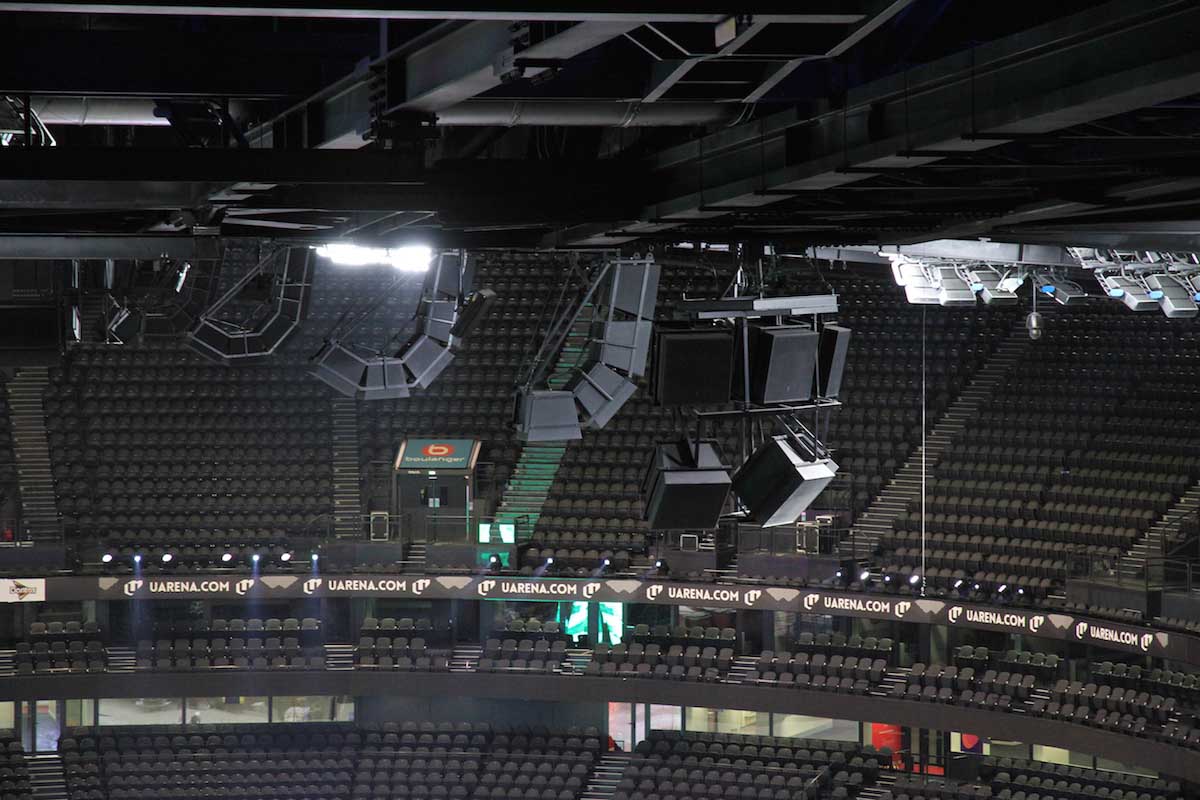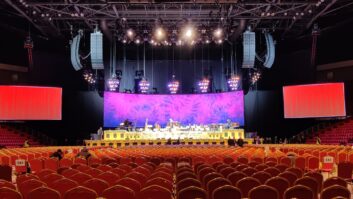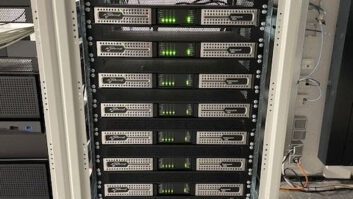
With capacity for 40,000 spectators in concert configuration, 32,000 for sporting events, the U Arena is the biggest indoor arena in Europe. It is situated in La Défense, a major business district, a few miles west of Paris. It was imagined by Jacky Lorenzetti, founder of the real estate group Foncia: a rugby fan, he bought his own team, Racing Métro, then offered them a place, “a performance hall in which one could play rugby!”. The arena was designed by star architect Christian de Portzamparc in 2011, the architectural acoustician was Jean-Paul Lamoureux, and works effectively began in 2014.
Difficult specifications
The U Arena has a closed roof and is huge, with 70,000sqm for the audience and 30,000 more for the office building on the other side of the giant screen (hence the ‘U’ shape). There were a number of challenges to be met in this project: instead of separate systems for public address and voice alarm, there was one single PA-VA system, with high-performance amplification and speakers and EN54 fire resistance certification; a Dante 32-channel optical fibre loop network throughout the building, with five nodes; a touchscreen user interface for zone selection and audio DSP configuration. Target sound pressure levels are 102dB for VA (from 250Hz to 8kHz), 105dB SPL for PA (80Hz-12kHz). And, above all, an STI (speech transmission intelligibility) value of at least 0.5 is mandatory, everywhere in the venue.
From an architectural point of view, the situation was less than ideal: acoustical studies began before the U Arena was built, and predicted a reverberation time of 6s (lowered to 4.5s after other simulations, with different tools, made by acoustic consultant Pascal Luquet of Bien Entendu). The first audio supplier mandated by AV integrator Vidélio specified a system, but was unable to meet the 0.5 STI value. After a year, enter Freevox, French distributor of most of the Harman Professional audio brands, including JBL.
Measuring STI
Freevox technical director Laurent Delenclos is a former top-league French live sound engineer, who has mixed and designed sound reinforcement systems for all kinds of stadiums and arenas. This one was tricky, but Delenclos had some ideas about what to do – and what not to do! He was helped by JBL, a genuine stadium PA specialist, which presented its PD500 Series at just the right time. The speakers host a 15in woofer and a compression driver, loaded with a specific horn, are available in several dispersion angles (the PD544 (40° x 40°) and PD564 (60° x 40°) are used here), and are capable of 133dB SPL.

Once EN54 certified, these speakers could be used, in their different directivity variants, to form the single PA/VA system that the customer wanted. “It wasn’t an easy task”, says Delenclos. “The easiest way would have been to put the speakers in a central cluster, but as the U Arena is a modular venue, it can be separated into several parts. Impossible, then, to send sound from the centre. So we had to distribute speaker clusters all around the sports ground, just above the edge of the stands, 28m high.
“This set-up creates important acoustical problems, as clusters interfere with each other. And as the venue can host sport events and live shows, we had to be able to send VA to the playing area, where people gather at a concert for example.”
Even with the PD500 speakers, 12 acoustical studies were necessary to meet the mandatory 0.5 STI value, plus several 400+-point measuring sessions with Pascal Luquet, right until the day before the venue opened. In all, there are 94 speakers and subs in the clusters, spread in 14 zones. Each speaker is powered by a single amplifier channel. It’s the first time PD500s have been used in France.
There are several kinds of clusters, made up of a different number of speakers, with different directivities to get the best coverage between top/mid/low stands and the playing area itself. That’s why the angulation of the boxes is sometimes amazing. Customised brackets had to be made by Stacco, a French specialist. Vidélio handled the installation and the cabling, which involved specially trained high-altitude workers, immune to vertigo. They could lift three clusters a day, working mainly at night so as not to bother the other workers in the venue.
New brand for Freevox
When Delenclos sent his results to Harman in the US for approval, he first got a negative answer: to guarantee the final result, it is impossible to use JBL speakers without Crown amplifiers, and none of them is EN54 certified, which is mandatory for VA systems. End of story? No, as JBL engineers pointed Delenclos to an English brand, ASL Control (Application Solutions Ltd).
“I didn’t know ASL Control, but found out they were distributed in France. They sell top-class EN54 Dante-compatible audio routers, paging systems, and high-power modular amplifiers. So I contacted them, and they had all that I needed: most important, the V2000, a 2U frame hosting 500W Class D cards, with back-up batteries. We finalised the project, approved by Harman Pro. I got training sessions in England, contacts were made, and a few months later, ASL Control was distributed in France by Freevox!” By the way, as subs are not used in the VA application, their amplifiers are not from ASL Control, but are Crown DCis. Some ASL Control amplifiers are used with the Control 16 ceiling speakers located under stands in public concourse zones.
There are only two amplifier rooms (West and East), which means loudspeaker cables can be very long. “Speakers are powered in 100V mode, and their cables have a 6sqmm cross-section. Their transformers are grouped by cluster in a dedicated fireproof box”, says Delenclos. The control room itself is blind, and situated in a corner of the hall, on the seventh floor. There’s a control touchscreen to pilot the 14 different zones and to call the appropriate preset for the event. The audio signals mainly come from a MacBook running Ableton LIVE, with a Focusrite Scarlett interface and a Launchpad Pro Novation control surface. In the audio racks are a Tascam CD player and SD recorder, plus Sennheiser evolution G3 wireless microphone receivers and IEM transmitters, plus an ASL Control VIPEDIA PRO audio router and two MPS30 paging stations. The mixing console is a Soundcraft SiExpression3 with a Dante card. The Dante network carries 32 channels, which are necessary as every cluster has specific EQ curves and delay times.
Future events
The U Arena was inaugurated by the Rolling Stones in October 2017. As ever, the band played on their tour PA system, but the pre-show ads and music were played on the JBL/ASL Control system. Delenclos confides: “On the second night, the Rolling Stones team asked me to run the system a little quieter – there was an audible quality difference with theirs!”
Then there was a SuperCross event – a high-SPL motorcycle show – where the in-house system was able to cut through the engine noise. And even if there is 102dB SPL on the ground (the legal limit in France), there’s only 40dB SPL outside. Residential buildings around are never impacted. A musical TV show followed, Stars80, then rugby and basketball fixtures. Roger Waters will play in the U Arena in June. So – a flagship installation for JBL and ASL Control, and one that people from other stadiums or arenas in France will want to visit.
www.asl-control.co.uk
www.beyerdynamic.com
www.bienentendu.fr
www.crownaudio.com
www.focal.com
www.focusrite.com
www.fostexinternational.com
www.freevox.fr
www.jblpro.com
www.novationmusic.com
www.sennheiser.com
www.soundcraft.com
www.stacco.com
www.tascam.com
www.videlio.com







